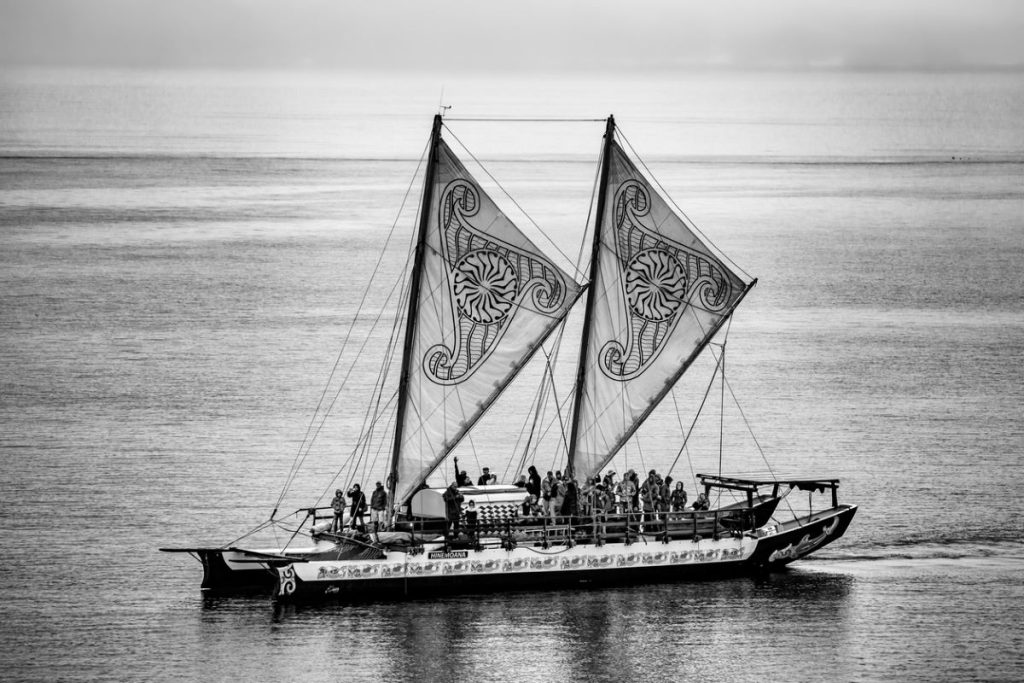The second Monday in October is observed federally as Christopher Columbus Day and elsewhere as Indigenous People’s Day. However, throughout Hawaiʻi it is known as Discoverers’ Day, in recognition of the Polynesian discoverers of the Hawaiian Islands. While the event is observed on this day, Discoverers’ Day is not a Hawaiʻi State holiday.
Since Discoverers’ Day is also the federal holiday Columbus Day, it is observed by federal employees as a day off and federal facilities (such as the Post Office) are closed. However, some private schools, businesses, or other organizations may close or hold special events in recognition of Discoverers’ Day. Read on for more details or to clear up any huikau (confusion) about what-is-what.
Discoverers’ Day
In Hawaiʻi, the second Monday in October is known as Discoverers’ Day. In 1972, Hawaii changed the name to Discovers’ Day in to recognize all discoverers, including Pacific and Polynesian navigators. It remained a state holiday until 1988 when it was removed as a state holiday but added the Birthday of Martin Luther King Jr. as a recognized holiday.
About Polynesian Explorers
Polynesians began settling in the Hawaiian Islands between 300 AD – 600 AD—estimates vary widely, and the initial date may be earlier or later. However, it was at least 1,000 years before the arrival of Captain Cook, which changed everything. But Cook is not what Discoverers’ Day is about.
Everyone is familiar with European “discovery” of the New World, including Captain Cook, Christopher Columbus, Magellan, and the Vikings. However, few people are aware of the history of Polynesian exploration and wayfinding which surpasses European discovers on many levels.
Polynesian wayfinding and discovery of the Hawaiian Islands was an astonishing feat. The Hawaiian Islands are less than 6,500 square miles rising in the middle of more than 70 million square miles of ocean—nearly one-third of the earth’s surface. It required considerable courage and skill to travel such distances when the destination was unknown.
Even today, ancient Polynesians are regarded with awe by some (me, at the very least) as the supreme navigators of oceanic travel. They routinely plied thousands of miles in outrigger or double-hulled voyaging canoes for weeks at a time—their vessels averaging 50-75 feet in length, holding 40-100 people.
They were guided not by compass, sextant, maps, magnifiers, or other navigational tools used by European explorers. Instead, Polynesians primarily used a “star compass” to determine their position, using their knowledge of the rising and setting point of the brightest objects in the night sky (planets as well as stars) to determine their direction.
To supplement the star compas, Polynesian navigators also noticed the flight of birds, cloud formations, ocean currents, wave patterns, and the behavior of sea creatures to tell them whether they might be approaching islands or atolls. On cloudy days when stars were not visible, the sun and moon could be helpful.
These earliest peoples brought with them plants and animals considered necessary for survival when landing on uninhabited, relatively barren islands. These “canoe” plants were necessary not only for food, but also for food wrappers, cordage, basketry, clothing, vessels, tools, drums, lamp oil, medicines, and other daily necessities.
Some canoe plants served several of these purposes. A few of the more well-known plants includes ʻawapuhi (non-edible “shampoo” ginger), kalo (aka taro), kī (aka ti), kō (sugarcane), kukui (candlenut), maiʻa (banana), niu (coconut), ʻohe (bamboo), ʻōhiʻa (mountain apple), ōhue or ipu (bottle gourd), ʻōlena (turmeric), ʻuala (sweet potato), uhi (yam), ʻuku (breadfruit), and wauke (paper mulberry). The list of indigenous versus introduced plants fluctuates as science continually uncovers new information about how long a plant has been growing in Hawaiʻi.
Traditional Polynesian navigation methods were nearly lost in modern times. In fact, at one time the idea that Pacific navigation was deliberate was debunked as a stroke of luck.
Fortunately, in the 1970s, the Polynesian Voyaging Society (hokulea.com) of Hawai‘i built a 60-foot double-hulled ocean voyaging canoe. The vessel was named Hokule‘a (“Star of Gladness”)—a reference to Arcturus, the brightest star in the Northern Hemisphere and guiding star for Hawaiian navigators. Since then, there have been several voyages to Tahiti and back.
About Columbus Day
Columbus Day is a U.S. federal holiday that commemorates the landing of Christopher Columbus in the Americas in 1492. Funded by the Spanish monarchy, Columbus was an Italian-born explorer who set sail in August 1492, intending to establish a shorter (and presumable safer) western sea route to China, India, and the lucrative spice trade at these locations.
In 1492, from October-December, Columbus’ three ships, the Nina, the Pinta and the Santa Maria made land in what we know today as the Bahamas, Cuba, and Hispaniola—believing each time he was somewhere in Asia. Columbus made several more voyages across the Atlantic, but never to China or India. Or North America for that matter. In other words, he did not “discover” what became the United States. Native Americans already knew all about it (more about this below).
The holiday was unofficially celebrated in a number of cities and states as early as the 18th century but did not become a federal holiday until 1937. Due to significant promotion of the holiday by Italian Americans and Catholic Church organizations, President Franklin D. Roosevelt officially proclaimed Columbus Day a national holiday. For many, the holiday was a way of honoring Columbus’ achievements as well as celebrating Italian American heritage.
Native American Day & Indigenous Peoples Day
Columbus was not the first European to “discover” the Americas. Five centuries before Columbus set sail, the Scandanavian Vikings established colonies in Greenland and Newfoundland. In fact, people of Anglo-Saxon descent wanted a federal holiday honoring Leif Erikson as the first European to reach the Americas but did not succeed over the voices of those promoting Columbus.
Since the 1970s, the significance of Columbus accomplishments have been challenged as representing the violent history of colonization in the Western hemisphere:
- Columbus Day celebrations have been challenged by anti-immigrant and anti-Catholic groups.
- Columbus history narrative has also been challenged by Native Americans protesting colonization of the Americas that lead to the deaths of millions of Indigenous People from disease and war, and as a harbinger of the transatlantic slave trade, which Columbus established in Hispaniola.
- In 1989, South Dakota became the first state to celebrate Native American Day instead of Columbus Day. Since then, alternative celebrations have been implemented to replace Columbus Day in cities and states across the country.
- Some states and individual cities have officially or legally changed the day to Indigenous Peoples’ Day or Native America Day, celebrated on the second Monday in October, either instead of or in addition to Columbus Day.
- Other states have stopped celebrating Columbus Day but have not replaced it. Some states, including Washington, have replaced it with something else.
Indigenous Peoples’ Day or Native America Day is intended to acknowledge the tribes (aka Native Americans) who were living in North America long before Europeans arrived on her shores. However, there is no national consensus, and the day is not without controversy. Your typical democracy angst.

Hinemoana Waka Polynesian sailing canoe, one of seven for the Te Mana o Te Moana (Spirit of the Ocean) 2011-2012 voyages – image by Stewart Watson via iStock by Getty Images
Event calendar for Discoverers’ Day (aka Columbus Day)
Listed below are events on our calendar for Discoverers’ Day (aka the federal holiday Columbus Day).
For more things to do anytime, see our calendar of free and cheap things to do every day (hawaiionthecheap.com)
multiple locations
